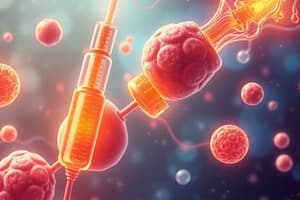Podcast
Questions and Answers
What is the first form of insulin produced during its synthesis?
What is the first form of insulin produced during its synthesis?
- Insulin
- Proinsulin
- Preproinsulin (correct)
- C-peptide
What primarily stimulates the secretion of insulin?
What primarily stimulates the secretion of insulin?
- Low levels of amino acids
- Increased glucose levels (correct)
- Decreased insulin levels
- High levels of fatty acids
Which part of the insulin receptor is involved in tyrosine kinase activity?
Which part of the insulin receptor is involved in tyrosine kinase activity?
- C-peptide
- Preproinsulin
- Alpha subunits
- Beta subunits (correct)
What happens to insulin once it is secreted into the bloodstream?
What happens to insulin once it is secreted into the bloodstream?
Which hormone is NOT known to stimulate insulin secretion?
Which hormone is NOT known to stimulate insulin secretion?
What role does C-peptide play in the body?
What role does C-peptide play in the body?
Which of the following is a physiological effect triggered by insulin binding to its receptor?
Which of the following is a physiological effect triggered by insulin binding to its receptor?
What inhibits insulin secretion in the body?
What inhibits insulin secretion in the body?
What role does insulin play in glucose metabolism?
What role does insulin play in glucose metabolism?
Which of the following accurately describes the function of glucagon?
Which of the following accurately describes the function of glucagon?
What physiological effect does insulin have on lipids?
What physiological effect does insulin have on lipids?
How does insulin affect potassium levels in the body?
How does insulin affect potassium levels in the body?
What is a characteristic of diabetes mellitus?
What is a characteristic of diabetes mellitus?
What is the primary effect of glucagon on the liver?
What is the primary effect of glucagon on the liver?
Which statement about insulin is false?
Which statement about insulin is false?
What happens to glucagon secretion when blood glucose levels are low?
What happens to glucagon secretion when blood glucose levels are low?
What harmful effect does persistent high blood sugar primarily lead to?
What harmful effect does persistent high blood sugar primarily lead to?
Which of the following is a consequence of capillary basement membrane thickening?
Which of the following is a consequence of capillary basement membrane thickening?
What does shunting of glucose to the polyol pathway primarily result in?
What does shunting of glucose to the polyol pathway primarily result in?
How does the accumulation of sorbitol affect cells?
How does the accumulation of sorbitol affect cells?
What is one of the roles of nitric oxide in blood vessels?
What is one of the roles of nitric oxide in blood vessels?
What condition can result from the promotion of coagulation due to AGEs?
What condition can result from the promotion of coagulation due to AGEs?
What is a potential consequence of increased capillary permeability caused by AGEs?
What is a potential consequence of increased capillary permeability caused by AGEs?
What does the generation of oxygen free radicals by AGEs lead to?
What does the generation of oxygen free radicals by AGEs lead to?
What is a consequence of persistent hyperinsulinemia?
What is a consequence of persistent hyperinsulinemia?
How does insulin resistance affect glucose levels in the blood?
How does insulin resistance affect glucose levels in the blood?
What condition results from high blood sugar over time?
What condition results from high blood sugar over time?
What is a result of insulin resistance in adipose cells?
What is a result of insulin resistance in adipose cells?
How does chronic hyperglycemia affect beta cells?
How does chronic hyperglycemia affect beta cells?
What effect does insulin resistance have on lipid metabolism?
What effect does insulin resistance have on lipid metabolism?
What is nonenzymatic glycosylation?
What is nonenzymatic glycosylation?
What leads to hyperlipidemia in the context of insulin resistance?
What leads to hyperlipidemia in the context of insulin resistance?
What is the primary effect of advanced glycation end products (AGEs) on the body?
What is the primary effect of advanced glycation end products (AGEs) on the body?
What condition is primarily characterized by damage to the blood vessels in the retina?
What condition is primarily characterized by damage to the blood vessels in the retina?
What is a common early sign of nephropathy in patients?
What is a common early sign of nephropathy in patients?
Which factor is associated with the acceleration of atherosclerosis in diabetic patients?
Which factor is associated with the acceleration of atherosclerosis in diabetic patients?
What does inappropriate protein kinase C activation disrupt?
What does inappropriate protein kinase C activation disrupt?
Which symptom can occur due to retinal ischemia?
Which symptom can occur due to retinal ischemia?
What is glomerulosclerosis?
What is glomerulosclerosis?
Which of the following is NOT considered a contributing factor to atherosclerosis in diabetes?
Which of the following is NOT considered a contributing factor to atherosclerosis in diabetes?
Flashcards are hidden until you start studying
Study Notes
Insulin & its Role in Metabolism
- Insulin: A hormone produced by beta cells in the Islets of Langerhans (pancreas) responsible for regulating carbohydrate and lipid metabolism, and has a minor impact on protein metabolism.
- Synthesis: Insulin is synthesized in three steps:
- Preproinsulin: Initial form of insulin
- Proinsulin: Preproinsulin is processed into proinsulin, which consists of three peptide chains (A, B, and C).
- Insulin: Proinsulin is further processed, removing the C peptide, leaving only the A and B peptides bonded together - the active form of insulin.
- C-peptide: Removed C peptide measures insulin production and might help slow down diabetes complications.
- Insulin Secretion: Driven by:
- Increased blood glucose levels
- Increased amino acids
- Increased free fatty acids
- Insulin Secretion Inhibition: Driven by:
- Low blood glucose levels
- High levels of insulin
- Other Stimuli: Gastrin, cholecystokinin (CCK), secretin, and parasympathetic nervous system stimulation.
- Insulin Action Cell:
- Receptors: Found on membranes of most cells to receive the insulin signal.
- Structure: Receptors have two alpha subunits binding to insulin and two beta subunits with tyrosine kinase activity.
- Activation Cascade: Insulin binding activates tyrosine kinase, leading to a series of physiological effects through protein kinase B (PKB) and MAP kinase.
- Glucose Uptake: Insulin activates a pathway that brings glucose transporter proteins (GLUT4) to the cell surface, facilitating glucose diffusion into the cell.
- Physiological Effects of Insulin:
- Control of postprandial plasma glucose levels: Insulin promotes glucose uptake into cells, reducing blood sugar after eating.
- Promotes glucose storage as glycogen: Facilitates storage of excess glucose in the liver and muscles as glycogen.
- Fatty acid synthesis and triglyceride formation: Promotes fatty acid synthesis and storage as triglycerides in adipose tissue.
- Transport of amino acids into cells and stimulates protein synthesis: Insulin helps transport essential amino acids into cells and stimulates protein synthesis.
- Stimulates cell growth and differentiation: Supports differentiation of cells into specialized types.
- Facilitates K+ transport into cells: Insulin facilitates potassium ion transport into cells.
Glucagon - Insulin's Counterpart
- Glucagon: Another hormone produced by alpha cells in the pancreas, opposing insulin's effects.
- Insulin Antagonist: Glucagon primarily acts on the liver, increasing blood glucose levels.
- Secretion: Glucagon release is triggered by low blood glucose levels, serving as a counter-regulatory mechanism for insulin.
- Physiological effects: Glucagon stimulates glycogen breakdown into glucose (glycogenolysis), glucose production from other sources (gluconeogenesis), fat breakdown (lipolysis), and ketone body production (ketogenesis).
- Limited Circulation: Glucagon primarily affects the liver, with minimal circulation to other tissues.
Diabetes Mellitus and Insulin Resistance
- Diabetes Mellitus: Characterized by problems with insulin activity, leading to high blood sugar and difficulty regulating glucose metabolism.
- Insulin Resistance: Cells become less responsive to insulin, making it harder for glucose to enter.
- Causes: Genetics, obesity, and other factors can contribute to insulin resistance.
- Adipokines: Obesity can elevate levels of adipokines (hormones released by fat cells), contributing to insulin resistance.
- Consequences of Insulin Resistance:
- Hyperglycemia: Elevated blood sugar levels due to reduced glucose uptake.
- Complications of Hyperglycemia:
- Osmotic diuresis: Increased urination due to excess glucose in the urine
- Hyperosmolarity: High blood sugar draws water out of cells, affecting their function
- Dyslipidemia: Insulin resistance affects lipid metabolism, leading to elevated levels of harmful cholesterol (LDL) and triglycerides, and decreased levels of beneficial cholesterol (HDL).
- Insulin resistance in adipose cells leads to lipolysis: Lack of insulin responsiveness in fat cells leads to fat breakdown (lipolysis), releasing fatty acids into the bloodstream.
- Hyperlipidemia: Ongoing insulin resistance leads to high levels of fat in the blood.
- Beta-cell destruction: Persistent hyperglycemia and high levels of fatty acids can contribute to the death or malfunction of beta cells, exacerbating insulin deficiency.
Chronic Complications of Diabetes Mellitus
- Pathophysiology: Hyperglycemia and its effects on protein structure underlie chronic complications.
- Nonenzymatic glycosylation: Glucose binds to proteins, lipids, and nucleic acids without enzymatic involvement, altering their structure and function.
- Advanced glycation end products (AGEs): Persistent high blood sugar leads to the formation of AGEs, which can cause:
- Capillary basement membrane thickening: Hinders nutrient and oxygen exchange, leading to reduced oxygen delivery.
- Increased capillary permeability: Leads to fluid leakage into surrounding tissues, impairing tissue function further.
- Promote arterial smooth muscle proliferation: Thickening of arterial walls leads to hypertension, plaque buildup, and eventual clogging of arteries.
- Generate oxygen free radicals: AGEs can cause blood vessel lining damage, leading to inflammation and further damage.
- Inactivate nitric oxide: Inactivation of nitric oxide leads to vasoconstriction (narrowing of blood vessels), increasing blood pressure and causing poor blood flow.
- Promote coagulation: Contributes to the formation of blood clots, leading to restricted blood flow and deep vein thrombosis (DVT).
- Shunting of Glucose to the Polyol Pathway: High blood sugar diverts glucose to the polyol pathway, converting it to sorbitol.
- Increased Osmotic Pressure: Sorbitol accumulation within cells increases osmotic pressure, drawing water into cells.
- Cell Swelling and Injury: Excess water can cause cell swelling and damage.
Specific Complications of Diabetes Mellitus
- Retinopathy: Damage to blood vessels in the retina (the back of the eye) due to retinal ischemia (reduced blood flow) caused by vessel thickening and clotting.
- Symptoms: Infarcts (tissue death) in the nerve layer of the retina, potentially leading to retinal detachment and hemorrhages (bleeding).
- Nephropathy: Kidney disease.
- Causes: Mechanisms involving hyperglycemia and its effects on glomeruli and tubules.
- Signs: Intraglomerular hypertension, thickening of the basement membrane, and glomerulosclerosis (scarring of the glomeruli).
- Clinical progression: Starts with proteinuria/albuminuria (protein in the urine) and can progress to chronic renal failure and eventually end-stage renal disease (ESRD).
- Macrovascular Disease - Atherosclerosis: Fatty deposits (plaque) build up in arteries prematurely in people with diabetes.
- Causes: Hyperglycemia, dyslipidemia, and AGEs contribute to atherosclerosis.
Studying That Suits You
Use AI to generate personalized quizzes and flashcards to suit your learning preferences.




